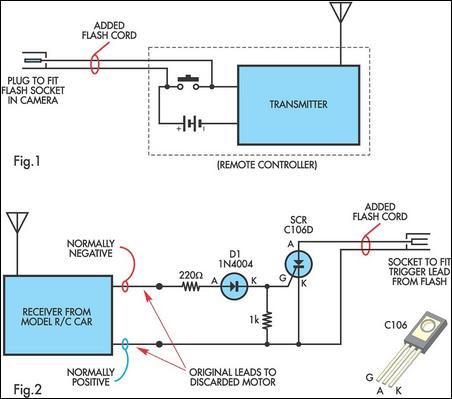Home » Circuits
Radio Controlled Electronic Flash
A radio controlled electronic flash is a useful item in any photographer's kit. Professionals use them all the time. For example, a wedding photographer would put one behind the bride to back-light her gown and veil. You don't want wires showing in a shot like that. To build this control you will need an old R/C car (the simplest sort) in which the car runs in reverse at switch-on and goes ahead only when the remote is operated. They can be picked up cheaply as school fetes and garage sales. A typical car will run from 3V (two cells) and use 9V in the transmitter.Before proceeding, make sure that the electronics in the car are operating. It doesn't matter if the wheels are broken or the motor is dead. You need to gain access to the leads to the motor. Normally (ie, without the remote operating), one is positive with respect to the other. Label them accordingly. On pressing the remote button, the polarity of the motor leads should swap. You will also need a flash extension cord you can cut into two sections. At the transmitter, the camera end of the extension cord is fed into the case and soldered to the control button contacts, as shown in Fig.1.
Circuit diagram:
The contacts are in series with the battery supply, so if you don't want to open the transmitter, just cut one of the battery leads and connect the flash extension cord into the gap so created. You will then need to tape down the remote button so that it is permanently operated (ie, closed). All that needs to be done at the receiver end is to connect the normally negative motor lead to the gate circuit of an SCR, as shown in Fig.2, while the normally positive lead goes to the cathode of the SCR. Now, when the transmitter is operated by the camera's contacts, the lead polarity is reversed and the SCR acts as a switch to fire a portable electronic flash via the other half of the flash extension cord.
The transmitter can be attached to the camera via a flash bracket or a screw into the tripod socket, depending on what is the most convenient arrangement. The added components in the receiver can be mounted on Veroboard and housed in the space where the electric motor was. If appearance is a primary consideration, the receiver and the added components could be mounted in a standard jiffy box.
Finally, a note of caution:
When connecting the flash end half of the extension cord to the SCR, make sure that it is the positive wire which goes to the anode of the SCR. Flash cords do not always have the centre wire connected to the centre pin of the plug. The centre pin of the lead on the flash unit will be positive and this must connect to the anode of the SCR via the lead connected to the R/C receiver.
Author: A. J. Lowe - Copyright: Silicon Chip Electronics

